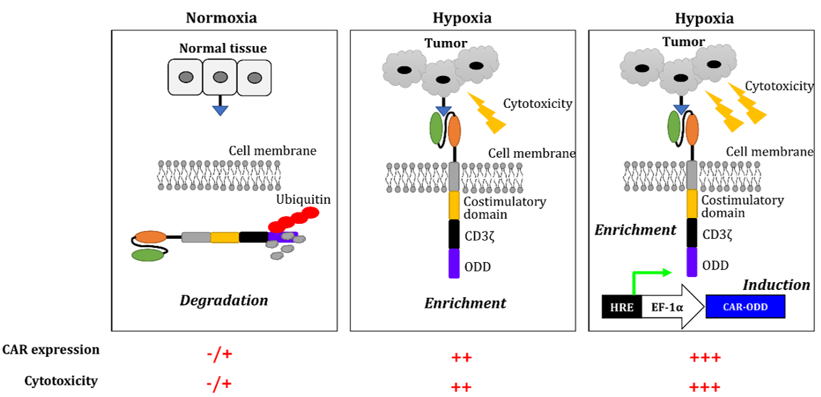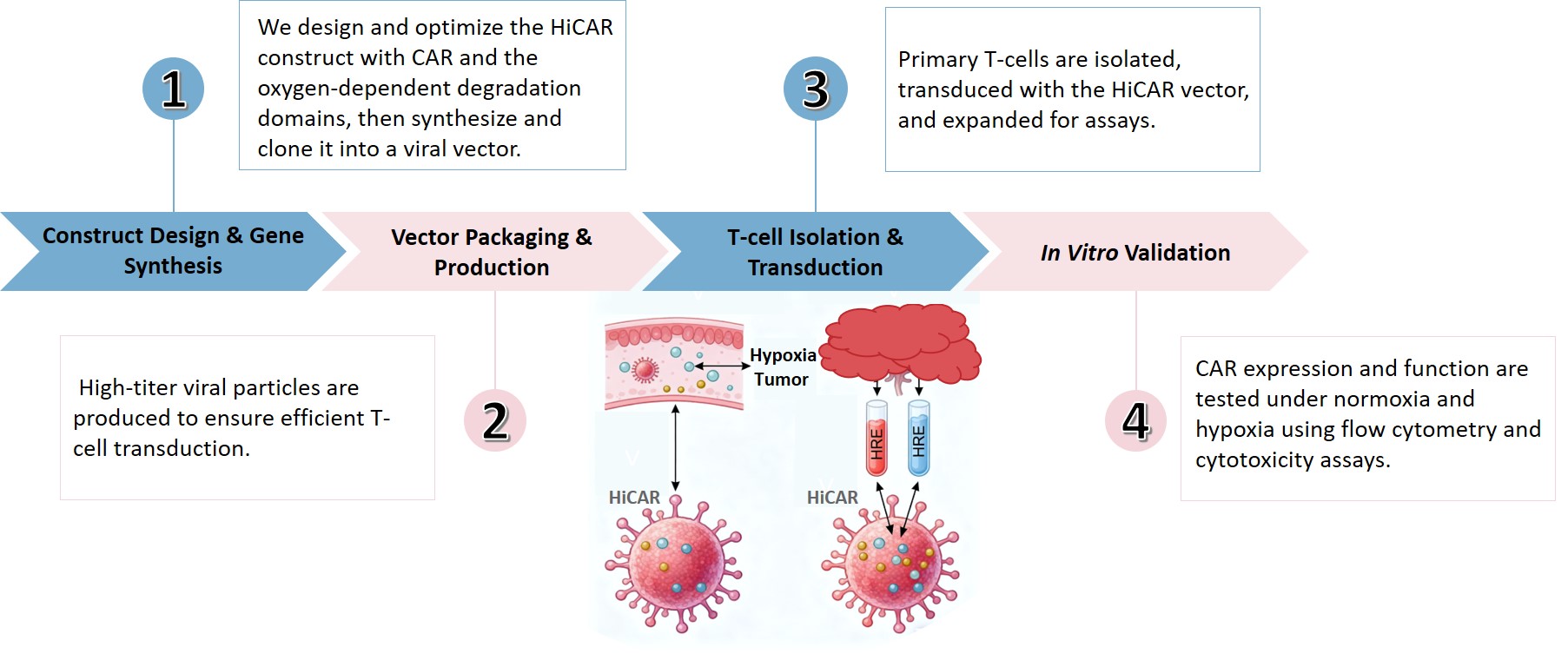Equipped with state-of-the-art facilities and experienced immunology experts, Creative Biolabs has expanded its service capabilities to offer a fully integrated HiCAR construction service. This new platform will accelerate the timeline for cell and gene therapy development to best suit your program requirements.
Chimeric antigen receptors (CAR) T cell therapy has generated exciting anticancer activities in recent years. Although the technology has achieved considerable progress in clinical cancer immunotherapy, which has also raised concerns associated with the "on-target off-tumor" effect, especially in healthy tissues expressed low level targeted antigen.
An attractive strategy to distinguish healthy tissue from cancer cells would be to dependent on key characters of the tumor microenvironment (TME). TME has been relevant to several conditions, such as, nutrient depletion, low extracellular pH (acidosis), and low oxygenation (hypoxia). Particularly, hypoxic microenvironment is a hallmark of the tumor microenvironment, often with < 1-2% oxygenation levels. Therefore, hypoxic microenvironment could as an advantage to boost CAR-T cell technology development to improve discrimination between tumoral and healthy tissues.
Creative Biolabs has developed a HiCAR technology platform. In which design require both antigen-recognition and hypoxia sensing to generate optimal T cell activity, thereby reducing on-target off-tumor toxicity. This design, using the oxygen-dependent degradation domain (ODD), can be especially useful for targeting common antigens presented by normal and neoplastic tissues.
Under the normoxic environment within normal tissues, HiCAR-engineered T cells maintain minimal surface CAR expression using the ubiquitination-proteasome degradation pathway. Hypoxia is a common hallmark of multiple solid tumors, and an increase in surface CAR presentation is shown on these engineered T cells when they are exposed to hypoxia within solid tumors. The insertion of a hypoxia-responsive element (HRE) upstream of a lentiviral vector promoter containing the HiCAR construct enhances the surface CAR expression to increase cytolytic potency under hypoxia.
 Fig.1 Schematic diagram of the working principle of HiCAR.1
Fig.1 Schematic diagram of the working principle of HiCAR.1
As an approach that takes advantage of environmental signal integration within a CAR design, HiCAR sensors are prone to rapid switch-down, which would protect distant healthy tissues. Besides providing additional levels of safety by minimizing "on-target/off-tumor" effects, HiCAR can also expand the number of surface antigens available for therapeutic purposes.
Creative Biolabs' scientists are dedicated to bringing together years of valuable experience to help our clients shorten the clinical study journey. We are committed to providing HiCAR platform to reducing the overall project development timeline for our clients. For further details, please don't hesitate to contact us and see how we can help you reach your clinical vision.
Our HiCAR construction service provides a comprehensive, end-to-end solution designed to accelerate your therapeutic development. We offer a full-service platform for the custom design, construction, and validation of your HiCAR-T cells. Our expertise ensures a streamlined process, from gene synthesis and vector construction to the engineering and validation of T-cell lines. You can expect a fully characterized and validated HiCAR construct, along with supporting data on its hypoxia-dependent expression and cytotoxicity profile. Our solutions are specifically tailored to address the challenge of solid tumors, enabling you to reduce off-target toxicity and expand your target antigen possibilities. We are your partner in bringing a safer, more potent generation of T-cell therapies to the clinic.
Discover How We Can Help - Request a ConsultationCreative Biolabs offers a suite of advanced technology platforms to support your HiCAR project from concept to preclinical validation. Our services include:

We have streamlined the HiCAR development process into a clear, methodical workflow to ensure efficiency and high-quality results for your project.

How is the HiCAR approach superior to conventional CAR-T therapy for solid tumors?
Conventional CAR-T can cause off-target toxicity by attacking healthy tissues that express the target antigen. The HiCAR system minimizes this risk by activating the CAR only in the hypoxic, low-oxygen environment of a solid tumor, ensuring a more precise and safer therapeutic effect. We are confident that this technology will advance your program.
Can your service be customized for different tumor targets or CAR designs?
Yes, absolutely. Our service is fully customizable. We can work with any target antigen and optimize the HiCAR construct to fit your specific research needs. We also provide full consultation to help you design a construct for optimal performance. Simply contact our team to discuss your project requirements.
Our HiCAR construction service combines extensive expertise with cutting-edge technology to provide a superior solution for your therapeutic development. We understand the unique challenges of developing CAR-T therapies for solid tumors and offer a platform designed to overcome them. Our commitment to quality and scientific rigor ensures that every project receives meticulous attention, from initial design to final delivery.
To learn more about our HiCAR CAR construction service or to discuss your specific project needs, please contact our team.
Reference
For any technical issues or product/service related questions, please leave your information below. Our team will contact you soon.
All products and services are For Research Use Only and CANNOT be used in the treatment or diagnosis of disease.
 NEWSLETTER
NEWSLETTER
The latest newsletter to introduce the latest breaking information, our site updates, field and other scientific news, important events, and insights from industry leaders
LEARN MORE NEWSLETTER NEW SOLUTION
NEW SOLUTION
CellRapeutics™ In Vivo Cell Engineering: One-stop in vivo T/B/NK cell and macrophage engineering services covering vectors construction to function verification.
LEARN MORE SOLUTION NOVEL TECHNOLOGY
NOVEL TECHNOLOGY
Silence™ CAR-T Cell: A novel platform to enhance CAR-T cell immunotherapy by combining RNAi technology to suppress genes that may impede CAR functionality.
LEARN MORE NOVEL TECHNOLOGY NEW SOLUTION
NEW SOLUTION
Canine CAR-T Therapy Development: From early target discovery, CAR design and construction, cell culture, and transfection, to in vitro and in vivo function validation.
LEARN MORE SOLUTION

